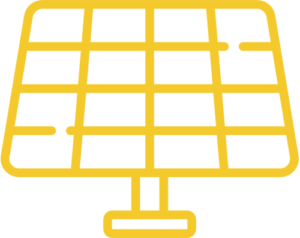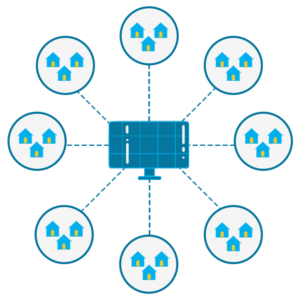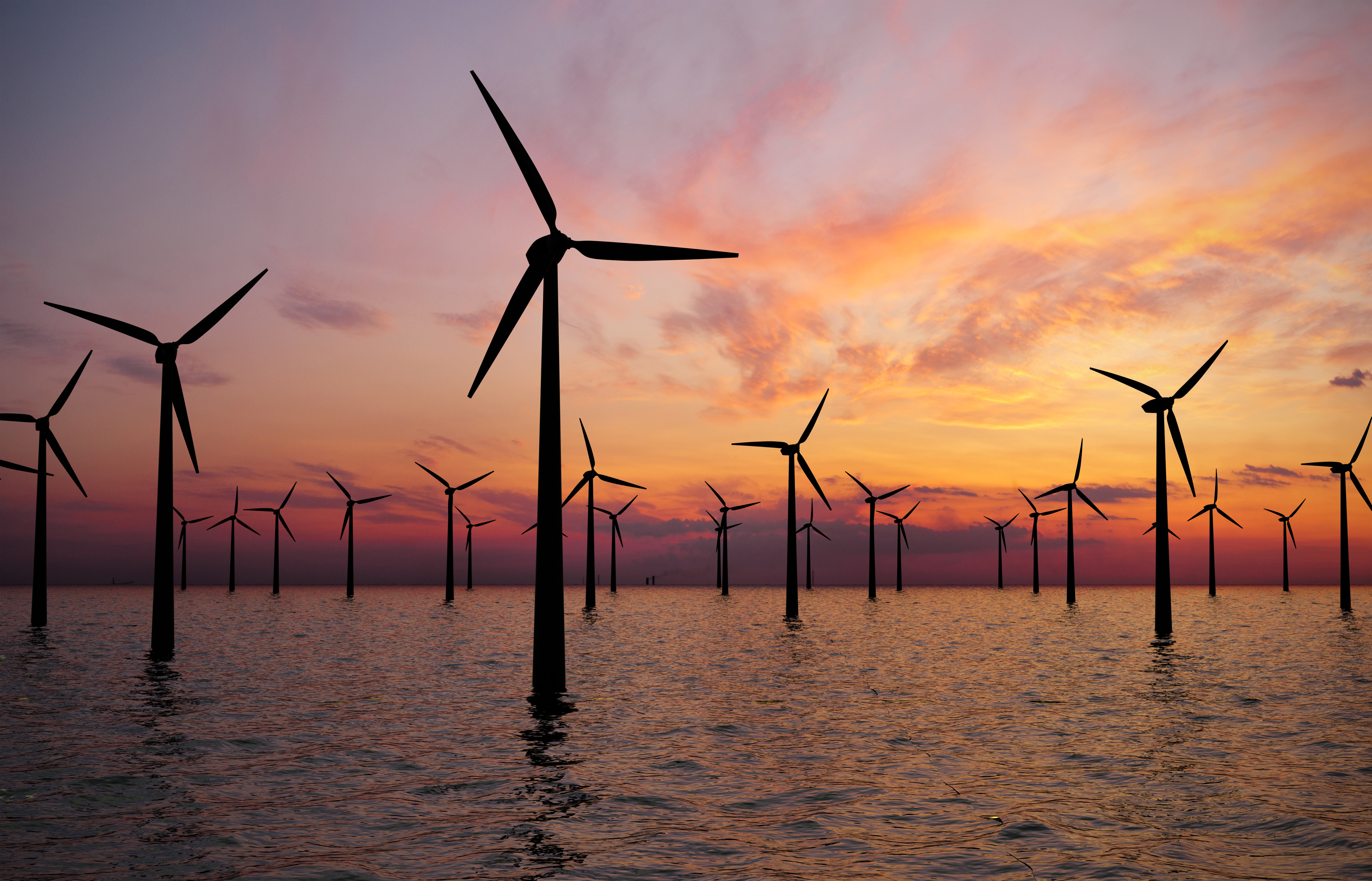Solar vs. Wind Energy
Solar Energy versus Wind Energy: A Fact Sheet Comparison
As renewable energy sources continue to grow and increase their contribution to the U.S. energy grid, it is increasingly common to see solar farms or wind farms across the nation. You may come across a massive wind farm where hundreds of wind turbines dot the landscape for as far as the eye can see. While there are other sources of clean energy, such as hydroelectric and geothermal energy, both solar and wind are the most commonly recognized forms and most available for individuals, businesses, or religious organizations looking to make the switch to clean, sustainable renewable energy.
Interested in comparing wind and solar options? The below fact sheet can help you decide which way to go.
Pros and Cons of Solar Energy Compared to Wind Energy
| PROS | CONS |
|
|
Pros and Cons of Wind Energy Compared to Solar Energy
| PROS | CONS |
|
|
Solar vs. Wind: Which is More Expensive?
Historically, wind power has been considered a less expensive option for producing renewable energy, especially on a commercial level. However, as solar panel technology continues to evolve, today commercial scale solar farms can produce solar energy for as low as $1.20 per watt, and that number could continue to drop. This puts commercial scale solar energy on par with large wind farms in terms of cost.
Few homeowners or communities, however, are going to have the financial resources to invest millions of dollars in hundreds of wind turbines or acres of solar panels. On a smaller, household level, a 5kW wind turbine should cost you about $32,000, including installation and all other necessary equipment. If placed in an area with a decent amount of year-round wind, this turbine could generate approximately 8,900 kWh per year. While community wind farms programs have yet to emerge the way Community Solar farms have, this might be an option in the near future for communities who live in areas where there is a steady source of wind. Because the wind is arguably less predictable than the sun, the variations in wind production can produce varying degrees of risk.
 On the other hand, for a similar amount of energy production, a household would need a 7 kW solar array. With the average cost of installed solar at $3.50 per watt, this would come to between $20,650 and $24,500 before the solar tax credit.
On the other hand, for a similar amount of energy production, a household would need a 7 kW solar array. With the average cost of installed solar at $3.50 per watt, this would come to between $20,650 and $24,500 before the solar tax credit.
The 26% solar tax credit, which is still available in 2020 would further reduce those costs, however, it is important to note that the Federal Government will be eliminating the solar tax credit by 2022. For many people, this might seem like a costly option. Furthermore, suppose you don’t own your home or don’t have the conditions necessary for installing solar panels on your roof or a massive wind turbine in your backyard. In that case, Community Solar farms are another option worth exploring that can drastically reduce the cost of accessing renewable, clean, energy.
Because the cost per watt with solar panels is much cheaper for larger scale projects, both homeowners and renters can choose to participate in a Community Solar Program. Clearway Community Solar is one company that operates Community Solar farms in several areas around the country, including Illinois, Massachusetts, New York, and Minnesota. By participating in a Community Solar program, customers can not only avoid having to assume the often prohibitive upfront costs that come with installing either solar panels or a large wind turbine, but will benefit from a reduced monthly electricity bill. This is because solar energy is almost always less expensive than the fossil fuel energies that continue to be a staple of the electricity offered by municipal utility companies.
 People who choose to participate in a Community Solar program, such as those offered by Clearway Community Solar might find instant savings from the reduced cost on their monthly utility bills.
People who choose to participate in a Community Solar program, such as those offered by Clearway Community Solar might find instant savings from the reduced cost on their monthly utility bills.
Another important consideration when comparing the costs of wind and solar energies is that wind turbines typically have more maintenance costs. While solar panels come with extended warranties of up to 25 years, most wind turbines only come with 10 year warranties, meaning that there is a good chance there will be a large amount of money in upkeep. Considering this, the actual cost per kWh is probably significantly less with solar power.
Levelized Cost of Electricity
| 2010 | 2021 | Percent change | |
|---|---|---|---|
| Bioenergy | 0.078 | 0.067 | -14% |
| Geothermal | 0.05 | 0.068 | 34% |
| Hydropower | 0.039 | 0.048 | 24% |
| Solar PV | 0.417 | 0.048 | -88% |
| CSP | 0.358 | 0.114 | -68% |
| Onshore Wind | 0.102 | 0.033 | -68% |
| Offshore Wind | 0.188 | 0.075 | -60% |

Solar vs. Wind: Which Has Greater Installed Capacity?
Despite the fact that solar energy might make more economic sense for homeowners, wind energy continues to outpace solar energy in terms of total installed capacity. According to the US Energy Information Administration, as of 2017 the United States had 254.25 TWh (terawatt hours) of installed wind energy and only 52.96 TWh of installed solar energy. The majority of wind power, however, comes from large, commercial wind farms, while much of the solar energy that makes up our national energy grid stems from smaller, more local Community Solar projects. In this sense, though wind power still has a greater installed capacity, solar tends to be more favored on an individual and community level.
Solar power continues to grow at an astonishing rate, and reports from last year show that the United States installed more solar power than any other type of electricity in 2018. Furthermore, while total wind capacity only grew 11.8 percent between 2017 and 2018, total solar energy capacity more than doubled by posting an impressive 27.9 percent growth rate.
Solar vs. Wind: Which is the Better Alternative?
The answer to this question will largely depend on your particular budget, the climate and region you live in, and your goals for renewable energy generation. The wind only blows steadily in certain areas. Especially in urban and suburban areas, to get the most energy from a wind turbine, you would ideally need to locate the wind turbines in areas where the wind is more constant, generally in higher elevations. The sun, however, shines almost everywhere. For homeowners whose roof is not correctly oriented towards the south or who have problems with excessive shading, participating in a Community Solar project is a better option for accessing renewable solar energy.
Both wind and solar offer certain advantages in some contexts, but also face challenges. If you live in an area where the wind blows regularly, investing in a wind turbine might be the best option. Solar power, on the hand, is available anywhere, from Antarctica to northern Canada and is most likely the most economically friendly option for renewable energy generation on a small scale.
Today, it is also possible to find hybrid solar panels and wind turbines. These systems allow homeowners and communities to enjoy the relatively constant source of energy from the sun during daylight hours and also continue to produce energy in the nighttime when winds are present.
Both solar and wind energies are fundamental to helping move our society towards an autonomous, carbon neutral and non-polluting energy grid. In some countries such as Norway where constant coastal winds are present, government and private industry investment in massive offshore wind farms might make economic sense. In almost every region, however, there are areas where solar energy can be harnessed for the local grid. Community Solar programs are usually the most cost-effective option and the most efficient way to produce a renewable, carbon emissions-free source of energy.
FAQs
What is solar energy?
Solar energy is the heat and light generated by the sun. The energy can be used to produce electricity by capturing it with photovoltaic cells, or it can be harnessed for heating and cooling applications. Solar thermal technology uses mirrors and lenses to concentrate sunlight onto a receiver, which captures the heat energy in a fluid that is then used to generate electricity. Solar energy is a clean, renewable resource that can power homes, businesses, and communities.
What is wind energy?
Wind energy is the kinetic energy of air molecules in motion created by uneven heating from the sun. Wind turbines capture and convert this energy into electricity. Wind power is one of the most cost-effective forms of renewable energy, meaning it can significantly reduce carbon emissions while still maintaining affordability for consumers.
Which is better, solar or wind power?
While wind turbines produce more energy than solar panels, solar provides a better source of renewable energy because they do not produce noise pollution, can be built near populated areas, don’t harm wildlife that flies aren’t an eyesore, and provide a more predictable source of energy.
Which is more efficient, solar or wind?
Wind turbines convert about 60% of the energy they pick up into electricity, and solar panels turn 20% of the energy they absorb into electricity.
What are the 4 main types of solar energy?
The four main types of solar energy are photovoltaic (PV) cells, which convert sunlight directly into electricity; concentrated solar power (CSP), which uses mirrors to concentrate the sun’s energy and generate heat or steam to drive a turbine; active solar heating systems, which use pumps to circulate heated water; and passive solar heating, which relies on the sun’s heat to naturally warm a building. Solar energy can also be used to generate hot water or power vehicles.
How wind energy is produced?
Wind energy is produced by using wind turbines to capture the kinetic energy of moving air, converting it into mechanical energy, and then further converting it into electrical power. The turbine blades are positioned to turn in the direction of the prevailing wind, capturing its energy and turning a generator connected to an electrical cable. This current is then transported to computers, homes, and businesses for various uses. Wind energy is also used to pump water and generate heat.
Additionally, the blades can be adjusted to take advantage of changing wind directions which helps to increase efficiency. Large wind farms have been built in areas with strong prevailing winds to provide electricity to entire cities or regions.
Join a Solar Farm Today
At Clearway Community Solar; we’re committed to helping you access sustainable, cost-effective energy solutions. Our solar farms are designed and built to maximize the power of the sun, providing clean, renewable energy that can be used to reduce your electricity bills. Join us today and take advantage of all solar energy’s benefits. learn more on how to enroll.



